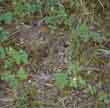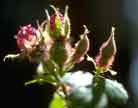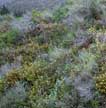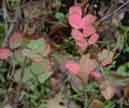



| Description | Distribution | Discussion | Horticultural Notes | Nomenclature | Links |

| 
|  | 
|
| open low-growing plants, most common after fires | prickles often numerous; flowers several | hips and sepal with abundant stalked glands | line drawing |
The primary distribution of the coast ground rose as currently understood is in the North Coast Ranges, extending south to northern Monterey County and north to southwestern Oregon. An apparently disjunct cluster of populations in the Los Osos region of San Luis Obispo County has certain peculiarities, specifically a tendency to have significantly thicker prickles and only sporadically glandular hips, perhaps intergrading with R. californica. As noted by Hoover (1966, Leafl. W. Bot. 10: 337--350), plants from this area "constituted a uniform population, identical in all respects except that some had the receptacle entirely devoid of glands while others showed sparse to dense glands." Because these are only tendencies rather than clear-cut distinctions, the best taxonomic placement of these plants is still unclear. The type of Rosa granulata Greene is representative of this form.
Images of the San Luis Obispo extreme

| 
|
| Chaparral habitat of disjunct San Luis Obispo population | Atypically thickened prickles on San Luis Obispo plants |
Previous treatments have generally recognized two varieties within R. spithamea, with var. sonomensis having more prickles than the typical var. spithamea. I was unable to justify maintaining the two varieties based on the material available to me at the time I was preparing the treatment for The Jepson Manual (see Historical Background), and accordingly lumped both together. One result of subsequent studies, however, has been the realization that populations from northwestern California, as represented by the type specimen, are in fact notably less prickly than those from further south, lessening the differences between the Coast Ground Rose and Sierra Ground Rose. In fact, it may be that R. spithamea and R. bridgesii are botanical counterparts of the well-known "ring species" salamanders, in which one extreme form in the south Coast Ranges intergrades in northern California to another extreme that is best developed in the southern Sierra Nevada. Needless to say, more study is called for.
Rosa spithamea is apparently a member of California's well-known fire-following flora, with a twist. Plants persist between fires not as seeds but as inconspicuous, rarely flowering members of the scrub or forest understory. In this stage they are routinely mistaken for depauperate Rosa gymnocarpa, which is overall more common, but even vegetative plants can generally be recognized (with some practice) by the consistently shorter stature and relatively blunter, fewer leaves, which often turn strikingly scarlet in fall. Apparently only after fire removes the overstory, and covers the ground with nutrient-rich ash, does Rosa spithamea flourish and put on a prominent display of abundant flowers.

| Leaves turning crimson in fall |
Possible Synonyms (working list):
R. adenocarpa Greene, Leafl. Bot. Observ. Crit. 2: 261. 1912: Piper s.n., Mt Grayback in SW OR, 15 Jun 1904 (HT: US527765!; fragment at NY!) [hips of spithamea, but prickles and leaflet shape of bridgesii]
R. amplifolia Greene, Leafl. Bot. Observ. Crit. 2: 258. 1912: Applegate s.n.--Fish Lake, Jackson Co, OR, 18 Jun 1898 (HT: US381523!) [unusually large leaflets]
R. boland[e]ri Greene, Leafl. Bot. Observ. Crit. 2: 261. 1912: Bolander--Oakland Hills (HT: US45934!; IS: US!) = spithamea X gymnocarpa? [sepals persistent but hips glabrous, aspect of spithamea]
R. granulata Greene, Leafl. Bot. Observ. Crit. 2: 262. 1912: Brewer--San Luis Obispo Co., Apr 1861 (HT: US320920; fragment at NY!) [exceptionally thick prickles]
R. sonomensis Greene, Fl. Franciscana 72. 1891: Greene, Sonoma Co., Petrified Forest, 1883 (NY!) = spithamea